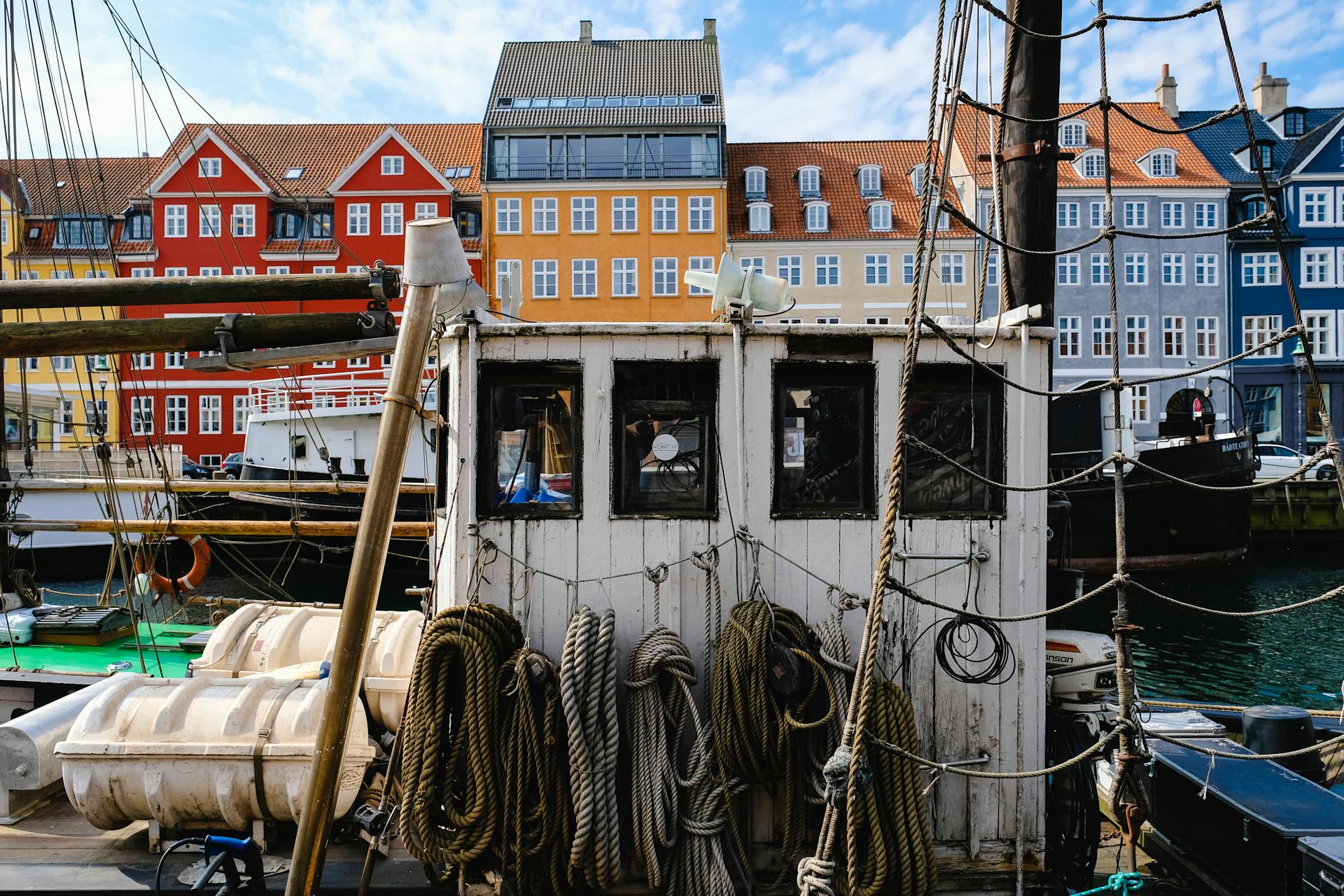
Home insurance policies can be complex, but understanding what's covered is essential for homeowners. Typically, home insurance covers sheds and other structures, but it depends on the type of policy and the structure's value.
The average cost of a shed can range from a few hundred to several thousand dollars, depending on its size and materials. Homeowners often use sheds for storage, but some use them as workshops or even guest houses.
In most cases, home insurance policies include a "dwelling coverage" clause, which covers the main house and attached structures like decks and patios. However, detached structures like sheds, garages, and fences may require separate coverage or be covered under a "personal property" clause.
Take a look at this: What Are the Three Main Types of Property Insurance Coverage
What Home Insurance Covers
Home insurance coverage can extend to other structures on your property, such as sheds and garages. However, individual policies vary, so it's essential to speak with your insurance broker to determine if your policy covers these structures.
Most home insurance policies cover other structures for the same disasters that your house is, including fire, hail, wind, and vandalism. This is on an "open perils" basis, meaning that as long as your policy doesn't specifically exclude a given problem, it's covered.
You should carefully read the "Other Structures" section of your policy to understand what's protected. This section will tell you what types of structures are covered, such as fences, detached garages, sheds, gazebos, guesthouses, driveways, and docks.
Other structures coverage pays only for the damaged structures themselves, not for anything stored inside. For example, if your shed catches fire and everything inside it is destroyed, other structures coverage would pay to rebuild the shed, but your personal property insurance would cover the items inside.
Here are some examples of other structures that are usually covered under your home insurance policy:
- Fence
- Detached garage
- Shed
- Gazebo
- Guesthouse
- Driveway
- Dock
Remember to check your policy to see if your swimming pool is covered under dwelling coverage or other structures coverage. If it's covered under other structures, make sure the limit is high enough to cover the cost of replacing it if it's damaged.
Additional reading: Can Insurance Cover Plan B
Not Covered by Home Insurance
Most homeowners policies have a detailed list of things they won't cover. Home insurance policies typically don't cover earthquake or flood damage, which requires an additional or supplemental policy.
You'll need to carefully read the "Other Structures" section of your policy to understand what's protected. Individual policies vary, so it's essential to speak with your insurance broker to determine what's covered.
Some damages, such as vandalism or theft, are covered under dwelling coverage, but you'll need to check your policy to see if it includes detached structures like sheds or barns. Your existing homeowners insurance policy may cover the cost of repairs, but the amount covered may be less than you expect.
Check this out: Why Is Anucort-hc Not Covered by Insurance?
Home Insurance for Sheds
Home insurance can extend to other structures on your property, such as sheds and garages, but individual policies vary. You should speak with your insurance broker to determine if your policy covers these structures.
Most homeowners insurance policies automatically include a certain percentage for other structures coverage, typically 10 percent of the value of your home. For example, if your home is worth $200,000, the maximum you could get for damage to an outbuilding or other structure is $20,000.
Detached structures insurance is available to protect sheds and garages that are separated from your dwelling by a clear space. This type of insurance covers structures such as detached garages, sheds, and gazebos.
Here are some examples of what detached structures insurance typically covers:
- Detached garage
- Shed
- Gazebo
Keep in mind that exclusions may apply, such as flood damage, earthquake or earth movement, and wear and tear. It's essential to review your policy carefully to understand what is covered and what is not.
Business
If you use your shed primarily for business, your homeowners policy might not cover it. This is because your homeowners policy is designed to cover personal property and structures, not business-related activities.
You may need business insurance to cover your shed if it's used for a landscaping company or a small shop. This is especially true if you have equipment or inventory stored in the shed.
Business insurance can provide liability coverage in case someone gets hurt on your property, and it can also cover damage to the shed itself.
Worth a look: Home and Business Insurance
Homeowners Insurance for Sheds
Homeowners insurance can provide coverage for your shed, but it's essential to understand the details. Most home insurance policies extend to other structures on your property, including sheds and garages.
You'll need to check your policy to see if it includes coverage for your shed. If it doesn't, you might have to add shed and garage coverage to your policy. It's also worth noting that individual policies vary, so it's best to speak with your insurance broker to determine what's covered.
Homeowners insurance will cover your shed and its contents from the same types of damage that your main residence is protected against, including fire, burglary, vandalism, and weather-related damage. This means that if your shed is damaged or stolen, your insurance provider will help cover the costs.
There are exclusions listed on your policy for things that home insurance will not cover, including flood damage, earthquake or earth movement, wear and tear, pest infestations, maintenance issues, and mold and wood rot.
Most homeowners insurance policies include 10 percent coverage for damage to barns, sheds, and other structures. For example, if your home is worth $200,000, the maximum you could get for damage to an outbuilding or other structure is $20,000.
Here's a rough estimate of how much coverage is available for other structures:
Keep in mind that this is just a general guideline, and you should read your policy carefully to determine what's covered. If you're unsure, it's always best to ask your insurance agent to explain your current policy.
Calculating and Increasing Coverage
Many insurance companies set your other structures coverage at 10% of your dwelling coverage limit, so if your dwelling is insured for $300,000, you'd have $30,000 of other structures coverage.
To determine if this amount is sufficient, consider the value of your detached structures, such as an in-ground pool and a large shed. If these structures are worth more than $30,000, you may need to adjust your other structures coverage limit.
Speak with your agent or insurance company representative to increase your coverage limits if necessary, especially if you have valuable items in your outbuildings.
For more insights, see: What Does Rental Dwelling Insurance Cover
How Much Do I Need?
Calculating how much coverage you need can be a bit tricky, but it's worth getting right. Many insurance companies set your other structures coverage at 10% of your dwelling coverage limit.
If your dwelling is insured for $300,000, you'd have $30,000 of other structures coverage. This might not be enough to replace valuable structures like an in-ground pool or a large shed.
You should speak with your agent or insurance company representative if you need to adjust your other structures coverage limit. They can help you determine the right amount for your specific situation.
Increase Limits
If you have outbuildings like sheds or garages, you might need to increase your coverage limits to protect them. Many insurance companies set your other structures coverage at 10% of your dwelling coverage limit, so if your dwelling is insured for $300,000, you'd have $30,000 of other structures coverage.
You should ask your broker about insuring individual items if they exceed your insurance coverage limits, as these items may not be fully covered under your standard policy. This is especially true for valuable items like guest houses.
Carefully reading the "Other Structures" section of your policy can provide invaluable insight into what's protected. It's essential to understand what's included and what's not to avoid any surprises.
If you have an in-ground pool and a large shed, for instance, $30,000 might not be enough to replace them if they're destroyed. You may need to adjust your other structures coverage limit to ensure you have enough protection.
Additional Costs and Liability
Personal liability coverage in homeowners insurance can be a lifesaver in the event of an accident. If a guest trips and falls in your shed and badly injures themselves, liability coverage could help pay for their medical expenses or legal fees if they decide to file a lawsuit.
You'll want to consider the costs associated with accidental injuries or property damage. This can include medical expenses, legal fees, and even court-ordered damages.
In extreme cases, liability coverage can help protect your assets, such as your home, savings, and other possessions.
A unique perspective: Does Motorcycle Insurance Cover Medical Bills
Other Costs

Other costs to consider when it comes to homeowners insurance include the cost of other structures coverage. The average cost of homeowners insurance in the U.S. is $1,915 per year.
Your rate will vary based on where you live and how much coverage you need. This means that even if you have a standard policy, your costs could still be higher or lower depending on your specific situation.
Other structures coverage will generally have the same deductible as your dwelling and personal property coverage, which is the amount of a claim you're responsible for.
If you're using one of your other structures for income, such as renting out a guesthouse to a tenant, you may need additional insurance to fully cover the building. This is because a standard homeowners policy likely won't cover a structure primarily used for commercial purposes.
You may be able to opt out of other structures coverage, depending on your insurer. However, this is something you should discuss with a local agent to determine the best coverage options for your area.
Here are the sample coverage limits and rates from NerdWallet's rate analysis:
Personal Liability
Personal Liability is a crucial aspect of insurance that protects you in case of accidents or property damage.
If you're found responsible for an injury or damage, liability coverage can help pay for medical expenses or legal fees. For example, if a guest trips and falls in your shed, liability coverage could help pay for their medical expenses.
As a homeowner, it's essential to understand the scope of your liability coverage. This coverage can help protect your assets in case of a lawsuit.
Liability coverage can be a lifesaver in unexpected situations, so it's crucial to have it in place.
Frequently Asked Questions
What is the amount of coverage that would be available for a detached garage?
Typically, a detached garage is covered for 10% of the dwelling coverage limit under a homeowners insurance policy's "Other Structures" portion. This amount may vary, so review your policy for specific details.
Sources
- https://www.nerdwallet.com/article/insurance/other-structures-coverage
- https://www.brokerlink.ca/blog/garage-shed-covered
- https://www.vosslawfirm.com/blog/tx-insurance-lawyer-coverage-for-damage-to-outbuildings.cfm
- https://www.policygenius.com/homeowners-insurance/does-homeowners-insurance-cover-sheds/
- https://nreig.com/is-it-covered-garages-fences-other-structures/
Featured Images: pexels.com


